Plant hydraulics drive the biological process that moves fluids from roots to plant stems and leaves, creating streaming electric potential, or voltage, in the process.
Tag: PHYSICS OF FLUIDS
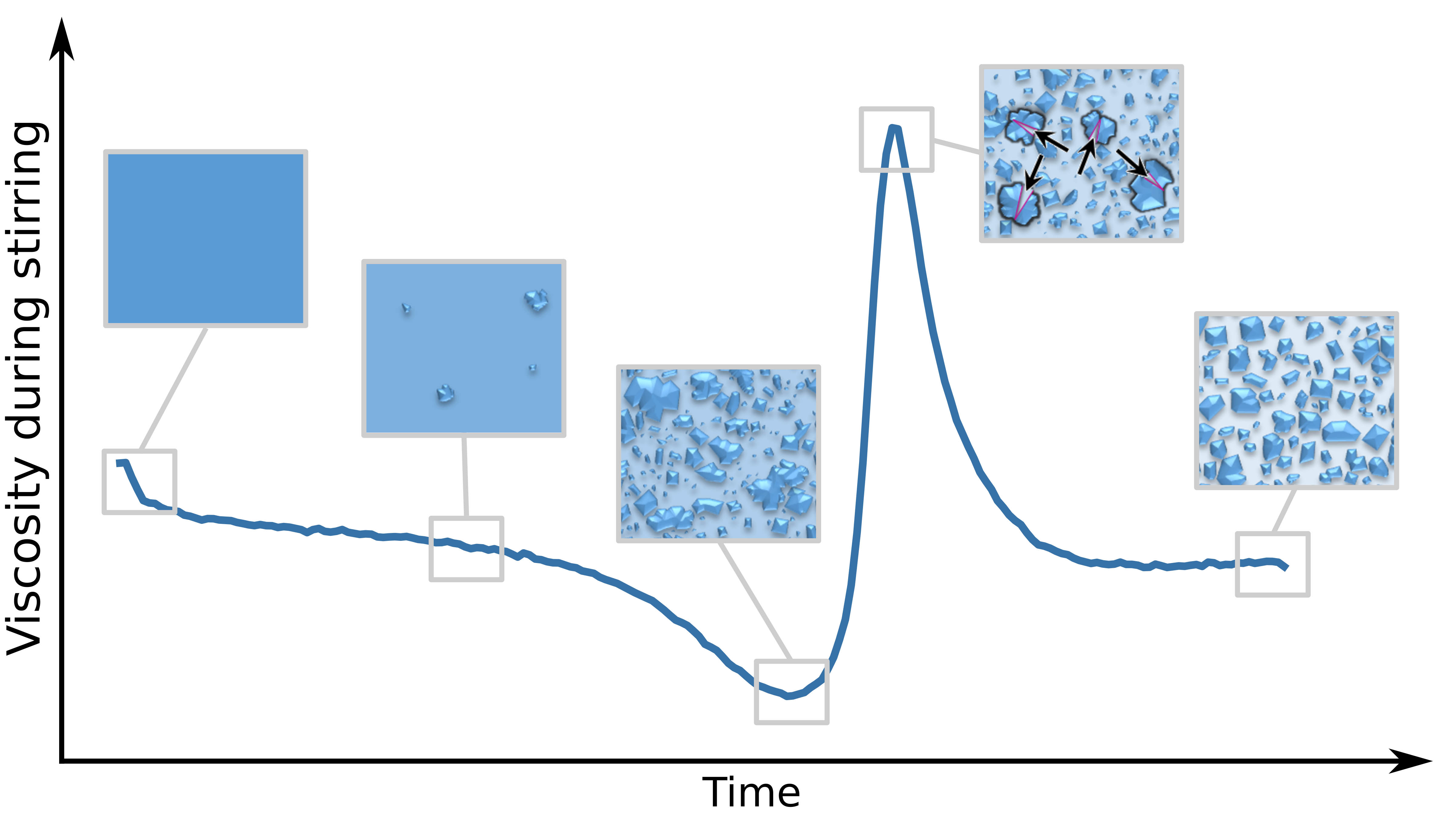
Fondant: Where Baking and Thermodynamics Mix
Researchers in Germany have studied the kinetic and thermodynamic processes of sugar crystallization in the making of fondant. In Physics of Fluids, they combine a controlled kneading machine with light microscopy to precisely observe the process of fondant creation and link it to theoretical physics models.
The Physics of Gummy Candy
In Physics of Fluids, researchers conduct a series of experiments that explore how changing key parts of the gummy-making process affects the final product, as well as how the candies behave in different storage temperatures. The group adjusted a variety of inputs while making the gummies, from the glucose syrup-to-sucrose ratio to starch and gelatin concentrations, to understand how these changes affected features like candy texture, moisture content, and pH. They used these results to identify the most shelf-stable combination for gummy candies.
Preserving Pine Forests by Understanding Beetle Flight
In Physics of Fluids, researchers from the University of Alberta study the flight performance of the mountain pine beetle from a fluid mechanics and an entomological perspective. Understanding these aspects of the insect’s flight could improve estimates of its spread through the environment and preserve pine forests. To examine insect flight, the team employed a type of model previously used for idealized airfoils. They showed that it can be successfully applied to multiple individual animals across biological sex, insect age, and body size. In doing so, the model can predict how these factors impact flight characteristics.
Extracting the Best Flavor from Coffee
In Physics of Fluids, University of Huddersfield researchers explore the role of uneven coffee extraction using a simple mathematical model. They split the coffee into two regions to examine whether uneven flow does in fact make weaker espresso. One of the regions in the model system hosted more tightly packed coffee than the other, which caused an initial disparity in flow resistance. The extraction of coffee decreased the flow resistance further. Understanding the origin of uneven extraction and avoiding or preventing it could enable better brews and substantial financial savings by using coffee more efficiently.
How to Land on a Planet Safely
In Physics of Fluids, researchers develop a model to describe the interaction between a rocket plume and the surface of a planetary body in near-vacuum conditions. The computational framework takes in information about the rocket, its engines, and the surface composition and topography, as well as the atmospheric conditions and gravitational forces at the landing site, and the results can be used to evaluate the safety and feasibility of a proposed landing site and to optimize the design of spacecraft and rocket engines for planetary landings.
Detecting, Predicting, and Preventing Aortic Ruptures with Computational Modeling
According to some estimates, up to 80% of patients who experience a ruptured abdominal aortic aneurysm will die before they reach the hospital or during surgery. But early intervention can prevent rupture and improve outcomes. In Physics of Fluids, researchers make a computational model of the cardiovascular system in order to predict early AAA rupture and monitor patients’ blood vessel conditions. They mimicked specific health conditions and investigated various hemodynamic parameters using image-based computational blood dynamics.
A Recipe for 3D-Printing Food
Additive manufacturing of food involves designing, pre-processing, manufacturing, and post-processing, and each step is an opportunity to create innovative foods. In Physics of Fluids, researchers identify factors that affect the print quality and shape complexity of the food created. For example, changing the printing patterns and ingredients of the initial mix or paste can affect the food’s matrix and microstructures and therefore its texture. Accounting for these features can increase food quality, improve control, and speed up printing.
Optimal Layout for a Hospital Isolation Room to Contain COVID-19 Includes Ceiling Vent
Researchers recently modeled the transmission of COVID-19 within an isolation room at the Royal Brompton Hospital in London, U.K. Their goal was to explore the optimal room layout to reduce the risk of infection for health care staff. To accomplish this, they used an adaptive mesh finite-element computational fluid dynamics model to simulate 3D spatial distribution of the virus within the room — based on data collected from the room during a COVID-19 patient’s stay. They share their findings and guidance in Physics of Fluids.
How to Shelter from a Nuclear Explosion
In Physics of Fluids, researchers simulate an atomic bomb explosion from a typical intercontinental ballistic missile and the resulting blast wave to see how it would affect people sheltering indoors.
Watching Water Droplets Merge on the International Space Station
In Physics of Fluids, researchers design and analyze droplet experiments that were done on the International Space Station. The researchers sent four different surfaces with various roughness properties to the station, where they were mounted to a lab table. Cameras recorded the droplets as they spread and merged. The experimental results confirmed and expanded the parameter space of the Davis-Hocking model, a simple way to simulate droplets.
Flying Snakes Help Scientists Design New Robots
In Physics of Fluids, researchers explore the lift production mechanism of flying snakes, which undulate side-to-side as they move from the tops of trees to the ground to escape predators or to move around quickly and efficiently. The investigators developed a computational model derived from data obtained through high-speed video of the snakes and considered several features, such as the angle of attack that the snake forms with the oncoming airflow and the frequency of its undulations, to determine which were important in producing glide.
Tiny Underwater Sand Dunes May Shed Light on Larger Terrestrial and Martian Formations
In Physics of Fluids, researchers have been studying the dynamics of how crescent-shaped sand dunes are formed. Known as barchans, these formations are commonly found in various sizes and circumstances, on Earth and on Mars. Using a computational fluid dynamics approach, the team carried out simulations by applying the equations of motion to each grain in a pile being deformed by a fluid flow, showing the ranges of values for the proper computation of barchan dunes down to the grain scale.
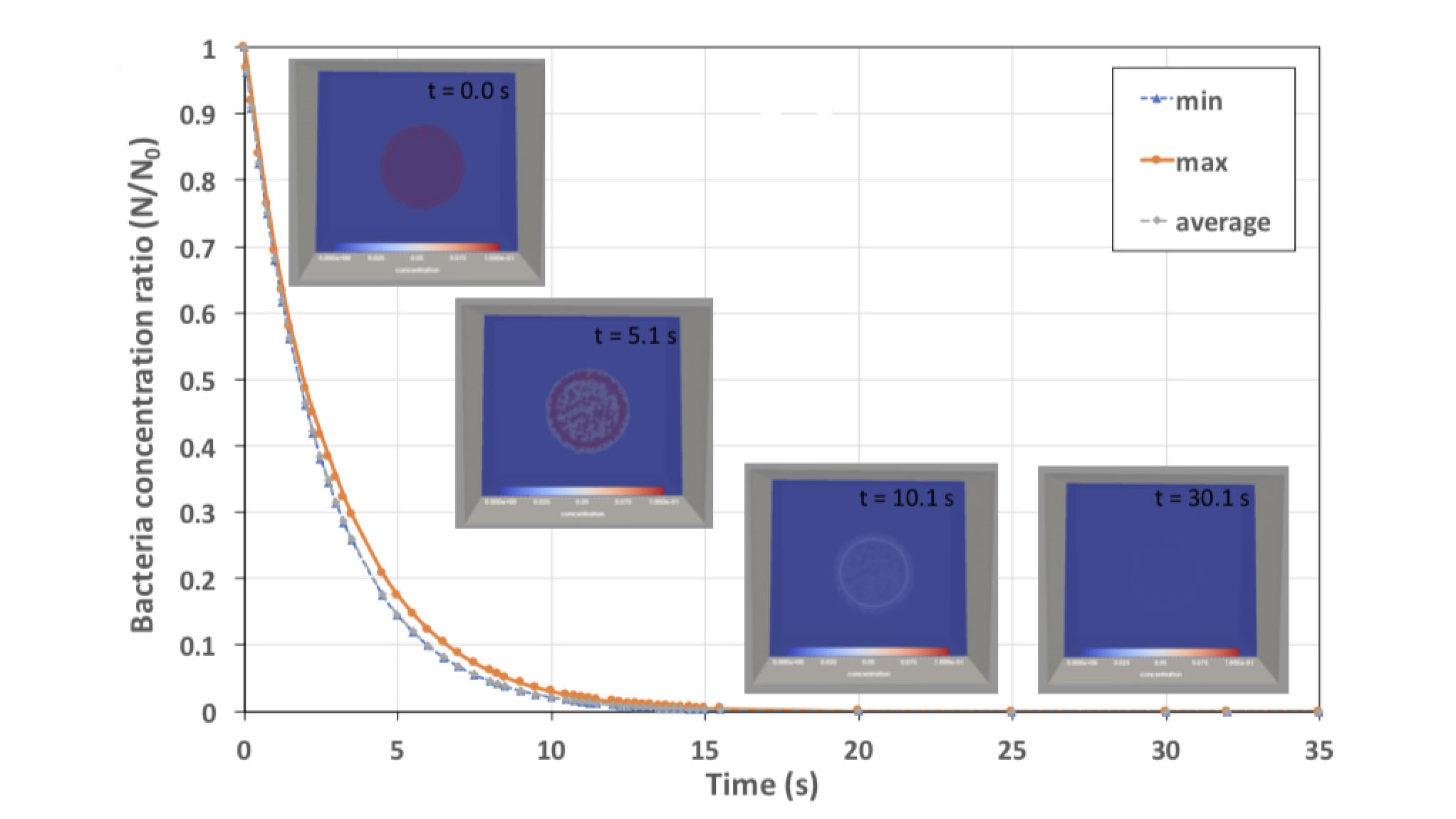
Washing Dishes with Superheated Steam More Effective, Earth-Friendly
Superheated steam dishwashers could provide a more effective, environmentally friendly solution than conventional dishwashers. In Physics of Fluids, researchers simulated such a dishwasher, finding that it killed 99% of bacteria on a plate in just 25 seconds. The model of an idealized dishwasher looks like a box with solid sides, a top opening, and a nozzle at the bottom. A plate covered with heat-resistant bacteria is placed directly above the nozzle. Once the plate reaches a certain threshold temperature, the microorganisms are deemed inactivated.
Body Posture Affects How Oral Drugs Absorbed by Stomach
A common method of administering drugs is orally, by swallowing a pill or capsule. But oral administration is the most complex way for the human body to absorb an active pharmaceutical ingredient, because the bioavailability of the drug in the gastrointestinal tract depends on the medication’s ingredients and the stomach’s dynamic physiological environment. In Physics of Fluids, researchers from employ a biomimetic in-silico simulator based on the realistic anatomy and morphology of the stomach – a “StomachSim” – to investigate and quantify the effect of body posture and stomach motility on drug bioavailability.

Uncorking Champagne Bottle Produces Supersonic Shock Waves
There is much more that comes out of the pop of an opening champagne bottle than meets the senses. In Physics of Fluids, computational fluid dynamics simulations revealed the formation, evolution, and dissipation of shock wave patterns as the carbon dioxide mixture shoots through the bottleneck in the first millisecond after cork popping. The findings could provide insight into the complex and transient behavior of supersonic flow in applications ranging from rocket launchers, ballistic missiles, and wind turbines to electronics manufacturing and underwater vehicles.
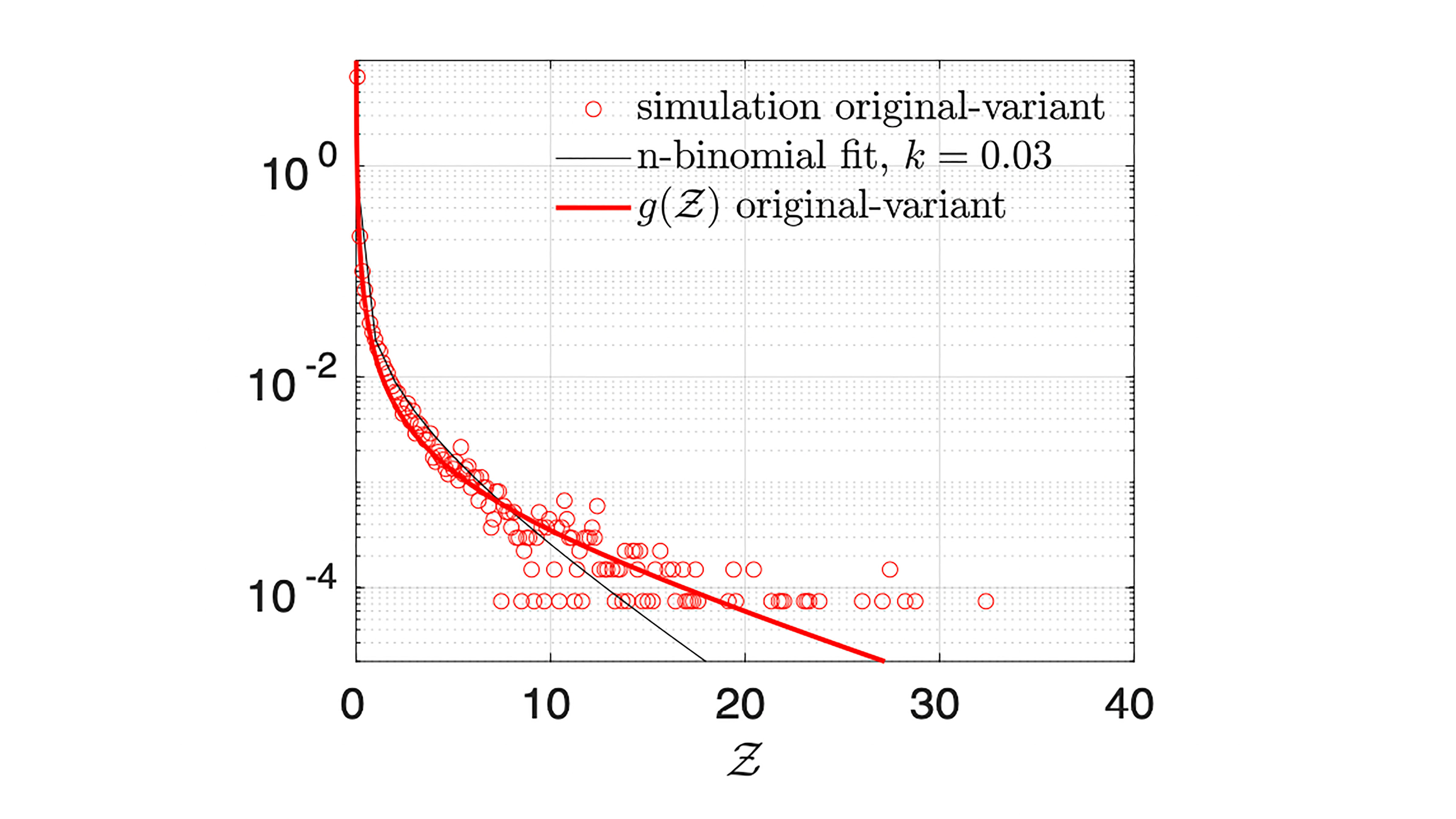
COVID-19 Superspreader Events Originate from Small Number of Carriers
In Physics of Fluids, researchers create a model to connect what biologists have learned about COVID-19 superspreading with how such events have occurred in the real world. They use occupancy data to test several features ranging from viral loads to the occupancy and ventilation of social contact settings. They found that 80% of infections occurring at superspreading events arose from only 4% of those who were carrying the virus into the event. The top feature driving the wide variability in superspreading events was the number of viral particles found in index cases.
Exploring Dynamics of Blood Flow in Vascular, Atherosclerotic Diseases
In Physics of Fluids, researchers present clinicians with information about the risk factors for atherosclerotic plaque formation from a mechanical point of view. The scientists are exploring whether it is possible to screen and intervene early for people at risk for atherosclerotic disease from the perspective of hemodynamics, using color Doppler ultrasound, coronary computed tomography angiography, and other screenings. The researchers used a multipoint, noncontact laser flow measurement method called microparticle image velocimetry.
At Home, Do-It-Yourself Fluid Mechanics
In Physics of Fluids, scientists describe their work on an at-home study of rheology, which is used to study the way non-Newtonian liquids or semisolid substances flow. The projects assigned to students had two parts: gathering qualitative visual evidence of rheological properties and taking quantitative measurements. The students checked for four behaviors – shear thinning viscosity, viscoelasticity, shear normal stress difference, and extensional viscosity – and even without access to laboratory rheometers, they developed creative and unique ways to carry out their measurements.
Face Shape Influences Mask Fit, Suggests Problems with Double Masking Against COVID-19
In Physics of Fluids, researchers use principal component analysis along with fluid dynamics simulation models to show the crucial importance of proper fit for all types of masks and how face shape influences the most ideal fit. They modeled a moderate cough jet from a mouth of an adult male wearing a cloth mask over the nose and mouth with elastic bands wrapped around the ears and calculated the maximum volume flow rates through the front of mask and peripheral gaps at different material porosity levels.
Ventilation Matters: Engineering Airflow to Avoid Spreading COVID-19
As we approach two full years of the COVID-19 pandemic, we now know it spreads primarily through airborne transmission. The virus rides inside tiny microscopic droplets or aerosol ejected from our mouths when we speak, shout, sing, cough, or sneeze. It then floats within the air, where it can be inhaled by and transmitted. This inspired researchers in India to explore how we can better understand and engineer airflow to mitigate the transmission of COVID-19.
Using Overpasses as Shelter From Tornado?
Meteorologists and emergency workers continue to contest the popular thinking that waiting out a tornado under an overpass is safe. According to the National Weather Service, doing so could actually increase the risk of death, in part because the wind from a tornado is thought to accelerate as it flows under the overpass, in what’s known as the wind tunnel effect.
Homemade Face Masks Work; Effectiveness Varies Depending on How They Are Made
In Physics of Fluids, by AIP Publishing, researchers from the Indian Institute of Science studied the fate of a large-sized surrogate cough droplets at different velocities, corresponding from mild to severe, while using various locally procured fabrics as masks.
Noninvasive Eye Procedure Provides Potential Pathway for Virus, Disease Carriers
In Physics of Fluids, by AIP Publishing, scientists from the Indian Institute of Science and the Narayana Nethralaya Foundation explain how tears ejected from the eye during a procedure that tests for glaucoma can theoretically transmit disease.
Nanofiber Face Masks Improve Filtration Efficiency, Need Replacing More Often
Innovations to improve mask efficacy, with increasing focus on nanofiber manufacturing, have resulted in higher filtration efficiency, greater comfort, and easier breathing capacity. However, the effects of microwater droplets on the integrity of nanofibers are relatively unclear. In Physics of Fluids, researchers examine these ambiguities through a visualization of nanofibers interacting with water aerosol exposure. They used high-speed microscopic videos to systematically visualize the evolution of nanofibers with different contact angles, diameters, and mesh sizes under water aerosol exposure.
Protruding Eyes, Mouth Make Stingrays More Hydrodynamically Efficient
In Physics of Fluids, researchers detail how the protruding eyes and mouths on simulated stingrays affect a range of forces involved in propulsion, such as pressure and vorticity. They created a computer model of a self-propelled flexible plate that mimicked a stingray’s up-and-down harmonic oscillations and used it to illustrate the complex interplay between hydrodynamic forces. The group found that the eyes and mouth help streamline stingrays even further.
Turning Plastic into Foam to Combat Pollution
In Physics of Fluids, researchers have developed a method to turn biodegradable plastic knives, spoons, and forks into a foam that can be used as insulation in walls or in flotation devices. The investigators placed the cutlery into a chamber filled with carbon dioxide. As pressure increased, the gas dissolved into the plastic. When they suddenly released the pressure in the chamber, the carbon dioxide expanded within the plastic, creating foaming.
Butterfly Effect Can Double Travel of Virus-Laden Droplets
In Physics of Fluids, investigators from the University of Florida and Lebanese American University carried out detailed computer simulations to test a mathematical theory they developed previously. They found nearly identical exhalations could spread in different directions when miniscule initial variations are substantially amplified by turbulence. This is the so-called butterfly effect.
Polymers in Meteorites Provide Clues to Early Solar System
Meteorites that do not experience high temperatures at any point in their existence provide a good record of complex chemistry present when or before our solar system was formed. So researchers have examined individual amino acids in these meteorites, many of which are not in present-day organisms. In Physics of Fluids, researchers show the existence of a systematic group of amino acid polymers across several members of the oldest meteorite class, the CV3 type.
First Wave COVID-19 Data Underestimated Pandemic Infections
Two COVID-19 pandemic curves emerged within many cities during the one-year period from March 2020 to March 2021. Oddly, the number of total daily infections reported during the first wave is much lower than that of the second, but the total number of daily deaths reported during the first wave is much higher than the second wave.
Fuel Flow, Heat Fluctuations Drive Dangerous Oscillations in Rocket Engines
Combustion engines can develop high frequency oscillations, leading to structural damage to and unsafe operating conditions. In Physics of Fluids, research clarifies the feedback processes that give rise to these oscillations. The investigators studied simulated combustion events in a computational model of a rocket combustor and their analysis involved sophisticated techniques, including symbolic dynamics and the use of complex networks to understand the transition into oscillatory behavior.
Normal Breathing Sends Saliva Droplets 7 Feet; Masks Shorten This
The WHO and the CDC recommend keeping a certain distance between people to prevent the spread of COVID-19. These social distancing recommendations are estimated from a variety of studies, but further research about the precise mechanism of virus transport is still needed. In Physics of Fluids, researchers demonstrate normal breathing indoors without a mask can transport saliva droplets capable of carrying virus particles to a distance of 2.2 meters in a matter of 90 seconds.
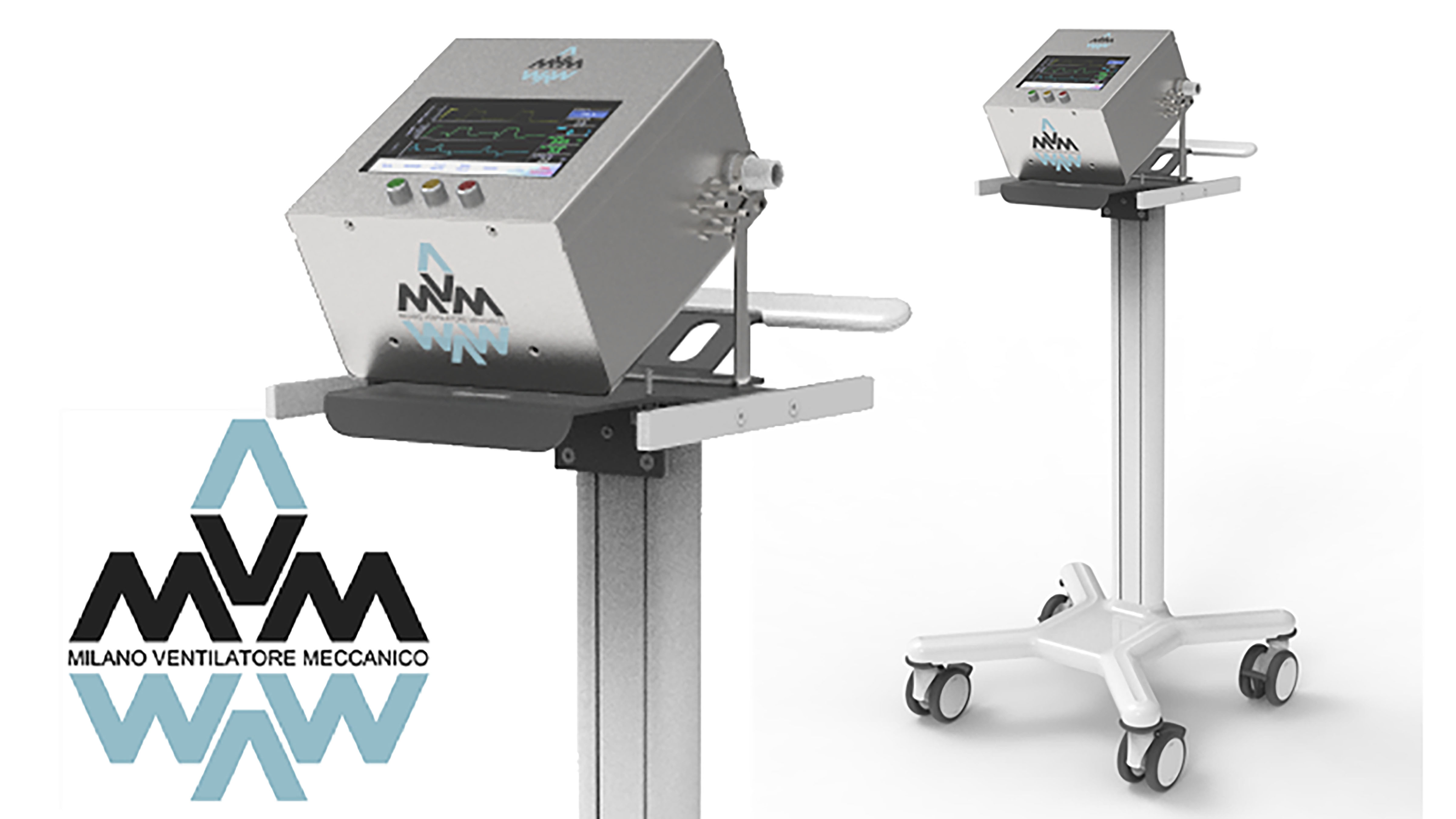
Cost-Effective, Easily Manufactured Ventilators for COVID-19 Patients
Particle physicists are at the forefront for pioneering low-cost, mass-producible ventilators to help address the worldwide shortage. An international, interdisciplinary team spearheaded one such effort and presents the design in Physics of Fluids. The ventilator consists of a gas inlet valve and a gas outlet valve, with controls and alarms to ensure proper monitoring and customizability from patient to patient. The design is built from readily available parts and is presented under an open license.
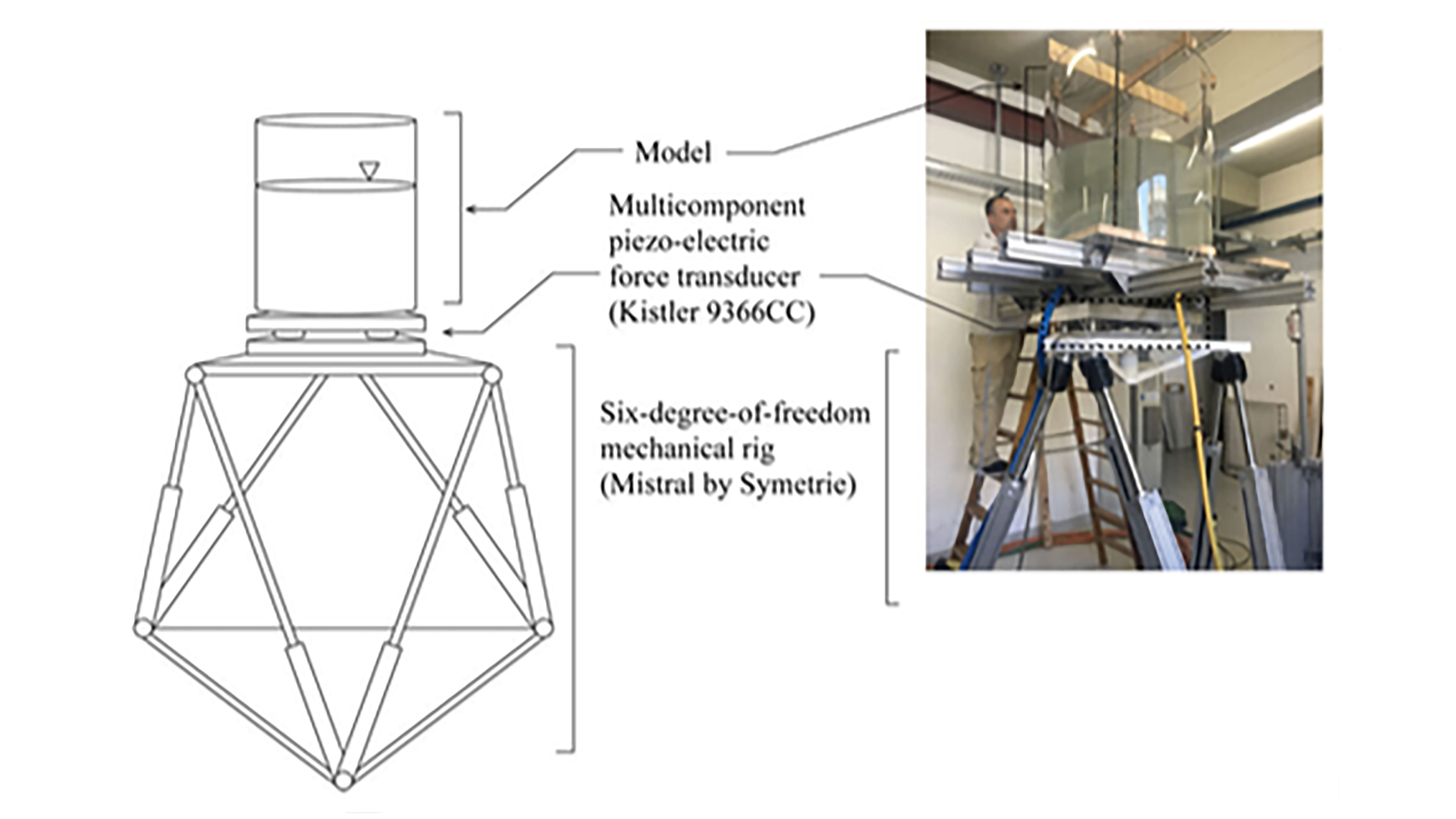
Controlling Sloshing Motions in Sea-Based Fish Farming Cages Improves Fish Welfare
Sea-based fish farming systems using net pens are hard on the environment and fish. A closed cage can improve fish welfare, but seawater must be continuously circulated through the cage. However, waves can cause the water to slosh inside the cage, creating violent motions and endangering the cage and fish. A study using a scale-model containment system is reported in Physics of Fluids and shows why violent sloshing motions arise and how to minimize them.
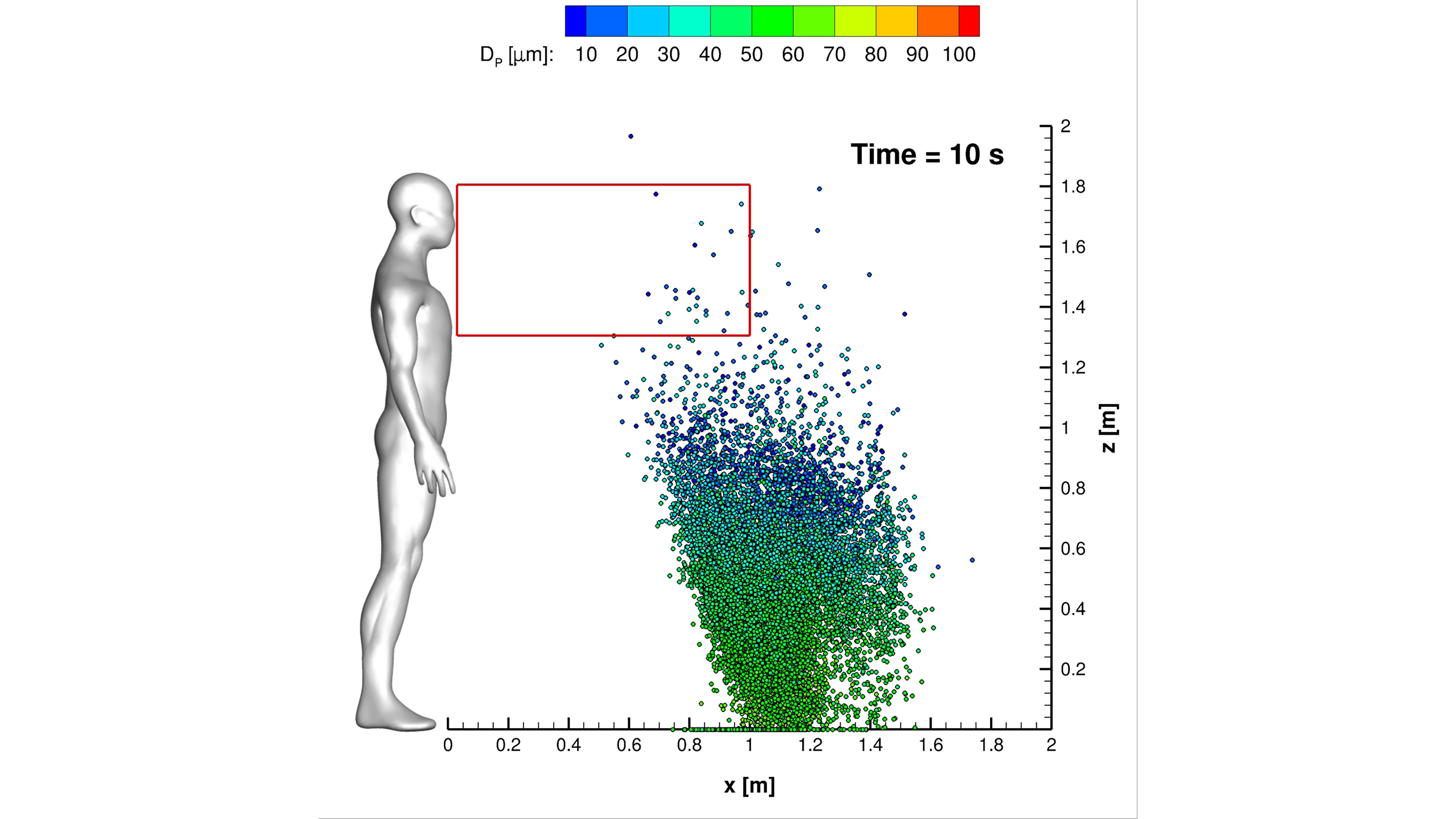
Irradiating COVID-19 Cough Droplets with UV-C Lamps
The extreme confusion at the beginning of the pandemic inspired Marche Polytechnic University researchers, who happen to be intrigued by saliva droplet diffusion, to search for answers and ways to help. In Physics of Fluids, they describe using a supercomputer to do numerical modeling of cough droplets irradiated by UV-C light. They also report exploring the social distances required to prevent virus transmission.
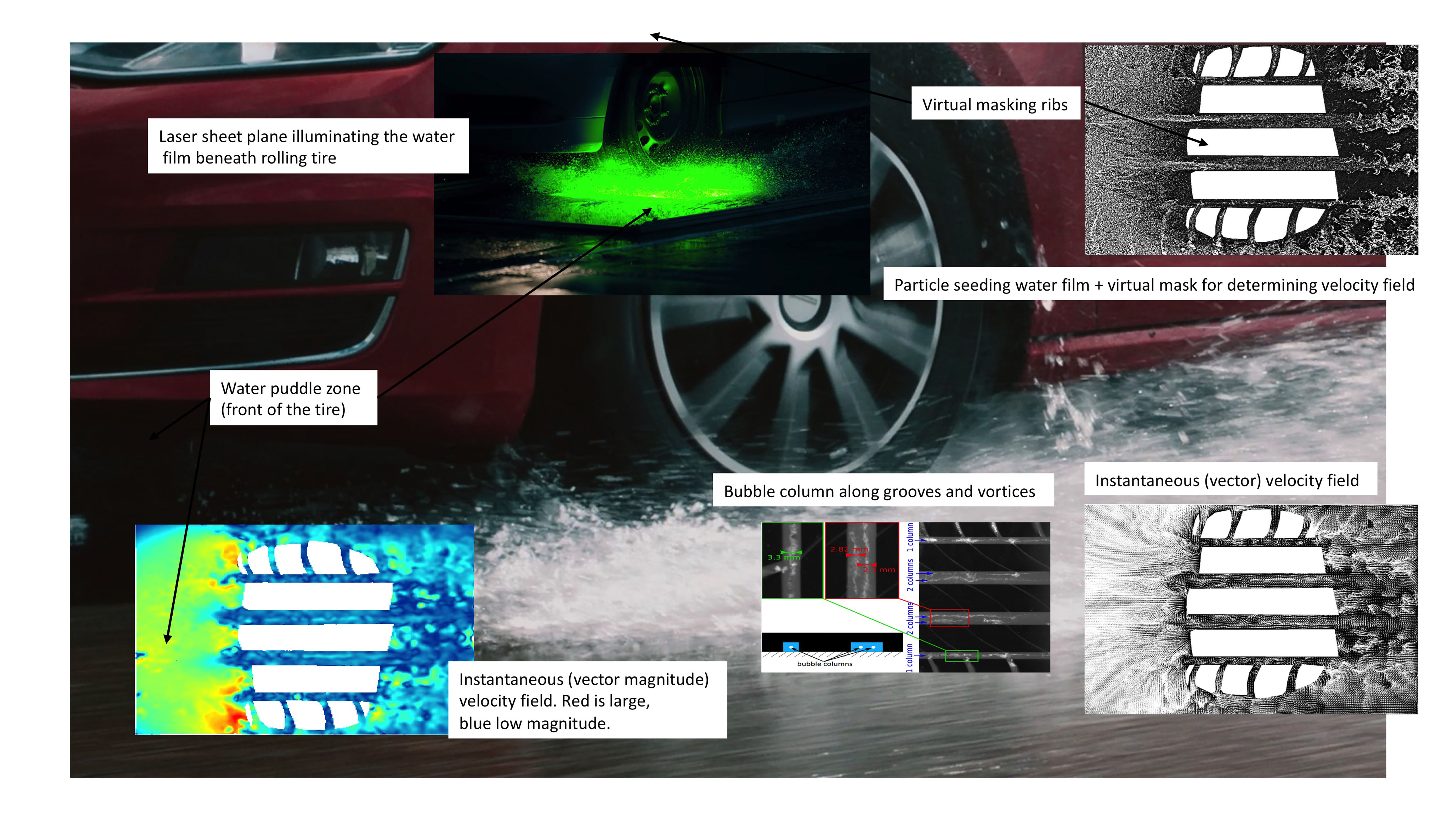
Complex Fluid Dynamics May Explain Hydroplaning
Research into hydroplaning currently uses a test track equipped with a transparent window embedded in the ground. The area above is flooded and a tire rolling over the window is observed with a high-speed camera. Investigators in France have developed a more sophisticated approach involving fluorescent seeding particles to visualize the flow and used a sheet of laser light to illuminate the area. They discuss their work in Physics of Fluids.
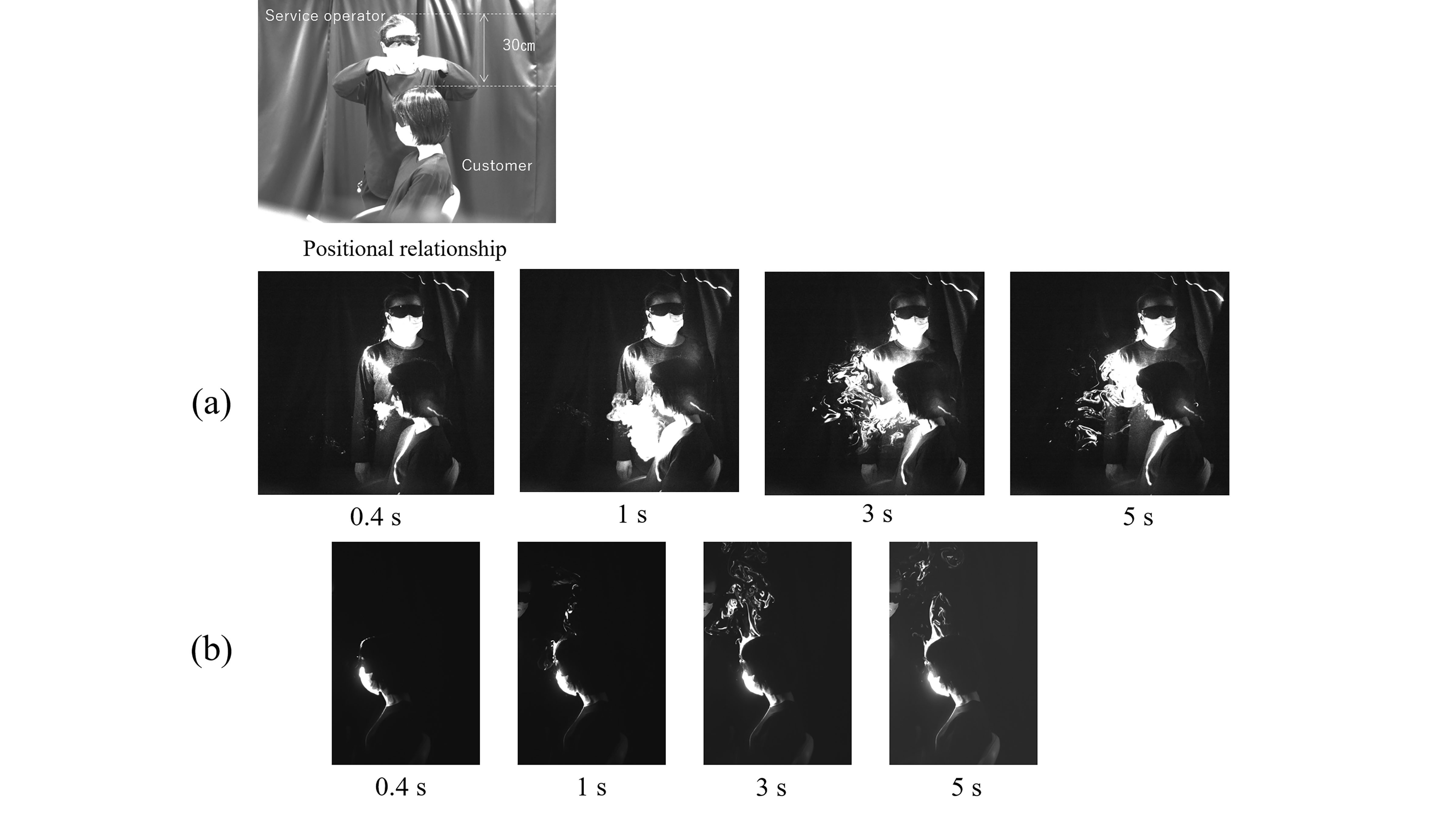
Simply Speaking While Infected Can Potentially Spread COVID-19
COVID-19 can spread from asymptomatic but infected people through small aerosol droplets in their exhaled breath. Most studies of the flow of exhaled air have focused on coughing or sneezing; however, speaking while near one another is also risky. In Physics of Fluids, scientists used smoke and laser light to study the flow of expelled breath near and around two people conversing in various relative postures commonly found in the service industry, such as in hair salons, medical exam rooms, or long-term care facilities.
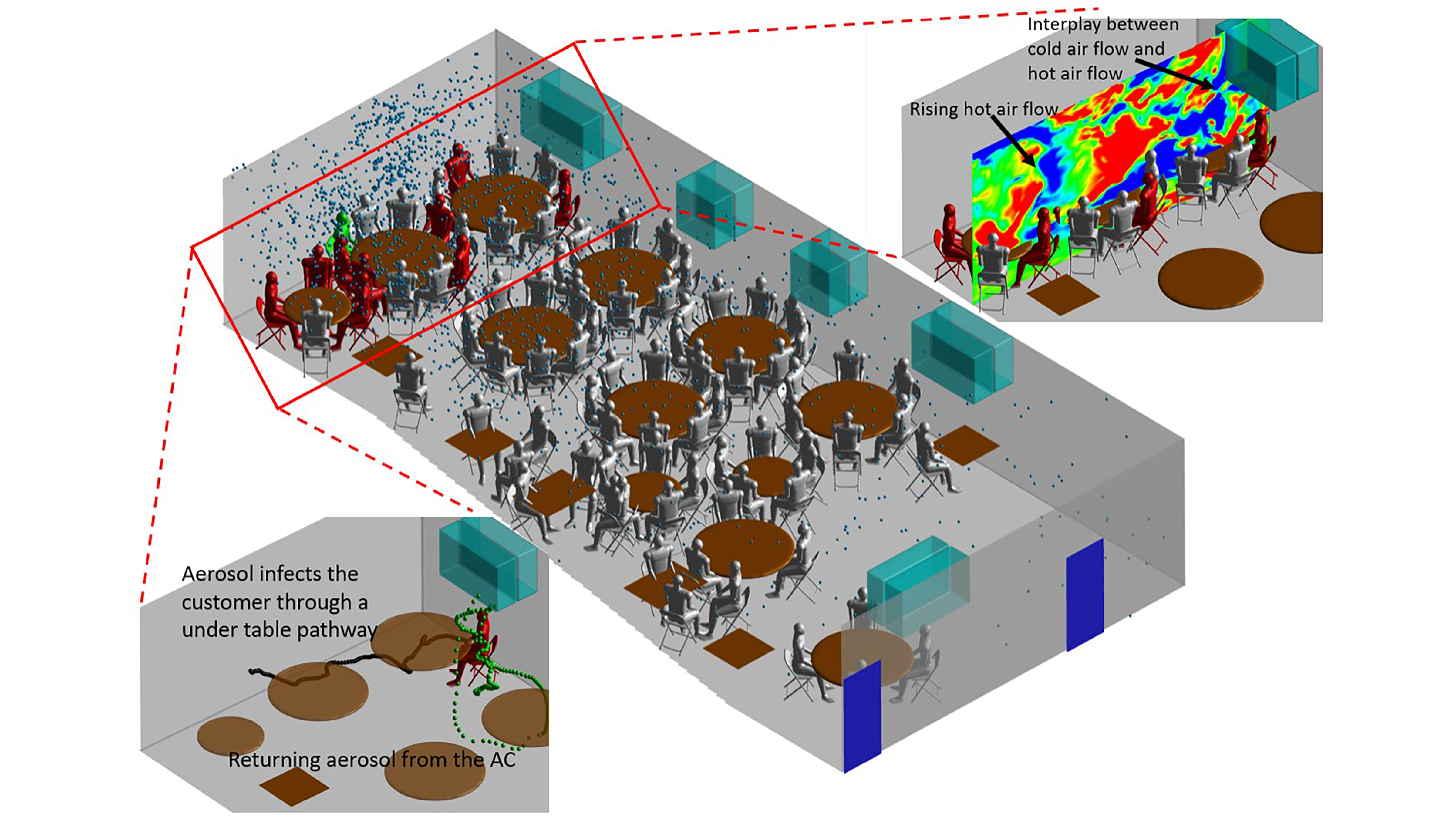
Advanced Simulations Reveal How Air Conditioning Spreads COVID-19 Aerosols
A restaurant outbreak in China was widely reported as strong evidence of airflow-induced transmission of COVID-19, but it lacked a detailed investigation about exactly how transmission occurred. In Physics of Fluids, researchers at the University of Minnesota report using advanced simulation methods to capture the complex flows that occur when the cold airflow from air conditioners interacts with the hot plume from a dining table and the transport of virus-loading particles within such flows.
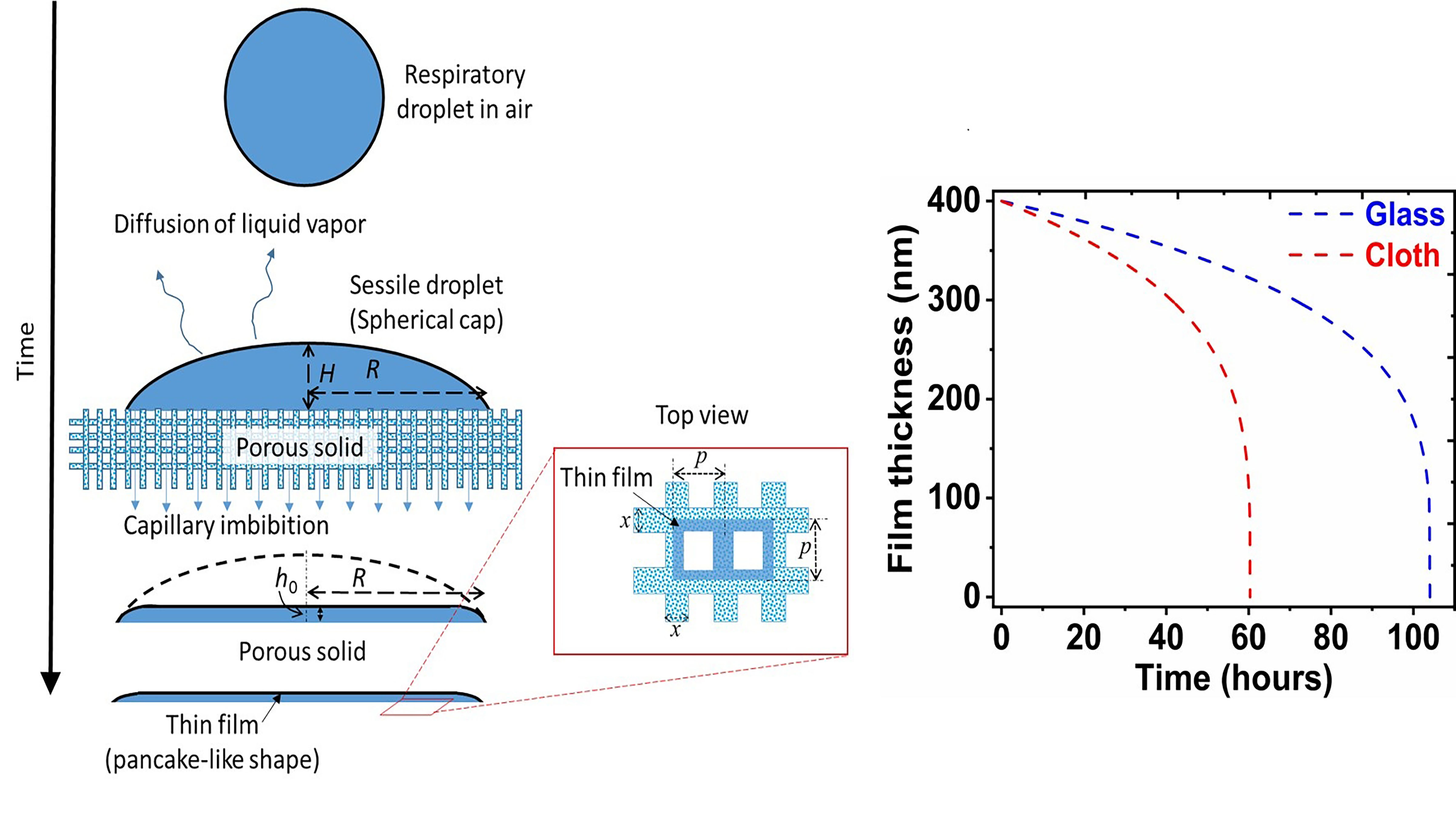
Porous Materials Unfavorable for Coronavirus Survival
As COVID-19 spreads via respiratory droplets, researchers have become increasingly interested in the drying of droplets on impermeable and porous surfaces; surfaces that accelerate evaporation can decelerate the spread of the virus. In Physics of Fluids, researchers show a droplet remains liquid for a much shorter time on a porous surface, making it less favorable to survival of the virus. On paper and cloth, the virus survived for only three hours and two days, respectively.
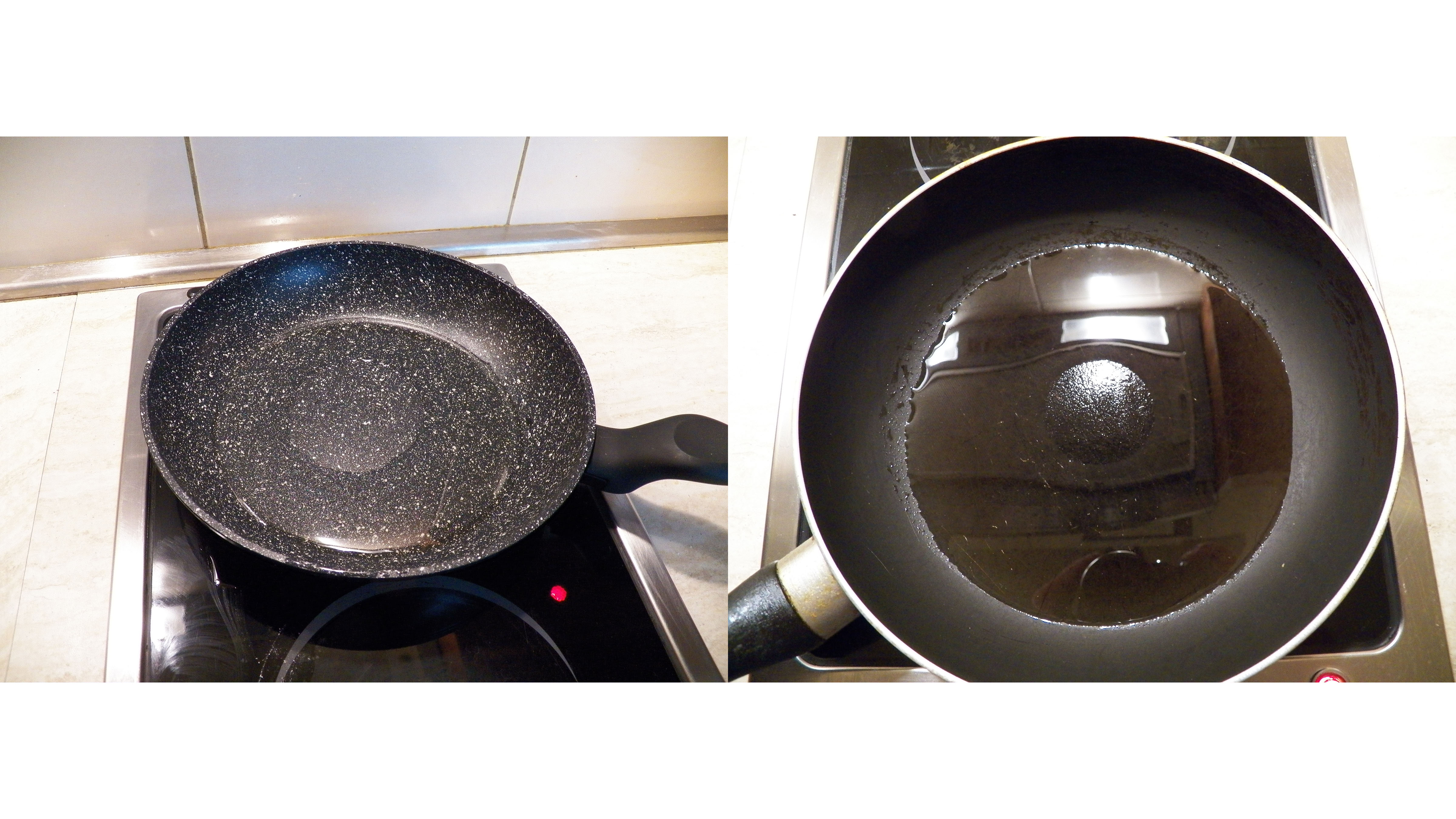
Why Food Sticks to Nonstick Frying Pans
Foods will sometimes get stuck to a heated surface, even if oil or a nonstick frying pan is used. Scientists have investigated the fluid properties of oil on a flat surface and their work, reported in Physics of Fluids, shows convection may be to blame. When the pan is heated from below, a temperature gradient is established in the oil film, as well as a surface tension gradient. This gradient sets up a type of convection known as thermocapillary convection.
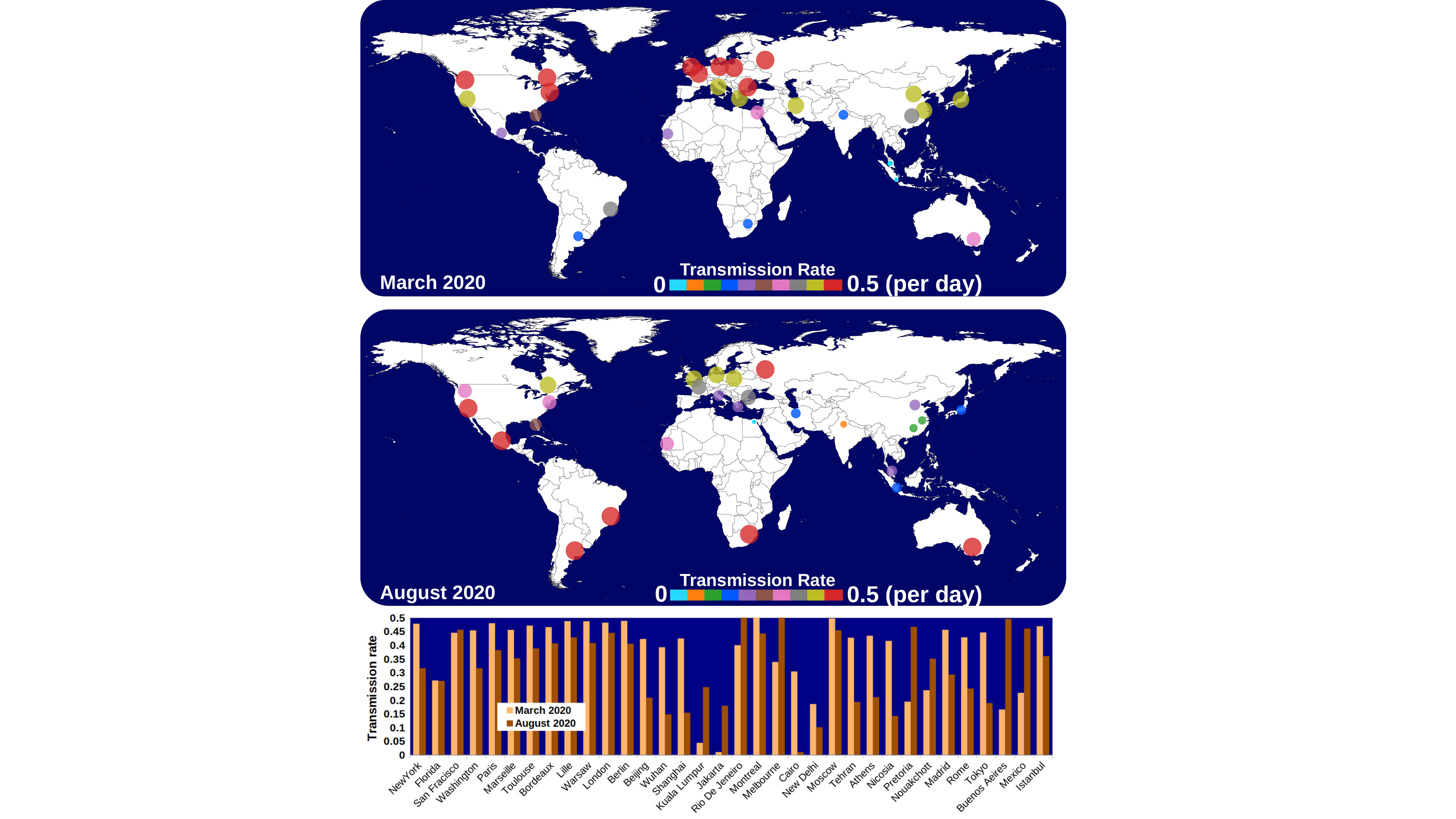
Temperature, Humidity, Wind Predict Second Wave of Pandemic
The “second wave” of the coronavirus pandemic has placed much blame on a lack of appropriate safety measures. However, due to the impacts of weather, research suggests two outbreaks per year are inevitable. Though face masks, travel restrictions, and social distancing guidelines help slow the number of new infections in the short term, the lack of climate effects incorporated into epidemiological models presents a glaring hole that can cause long-term effects. In Physics of Fluids, researchers discuss the impacts of these parameters.

Air Purifiers May Do More Harm Than Good in Confined Spaces with Airborne Viruses
The positions of air inlets and outlets in confined spaces, such as elevators, greatly affect airborne virus transmission. In Physics of Fluids, researchers show air purifiers may actually increase the spread. They use ultraviolet radiation to kill viruses and other microbes, but they also circulate air, sucking it in and exhausting cleaned air. This adds to overall circulation.
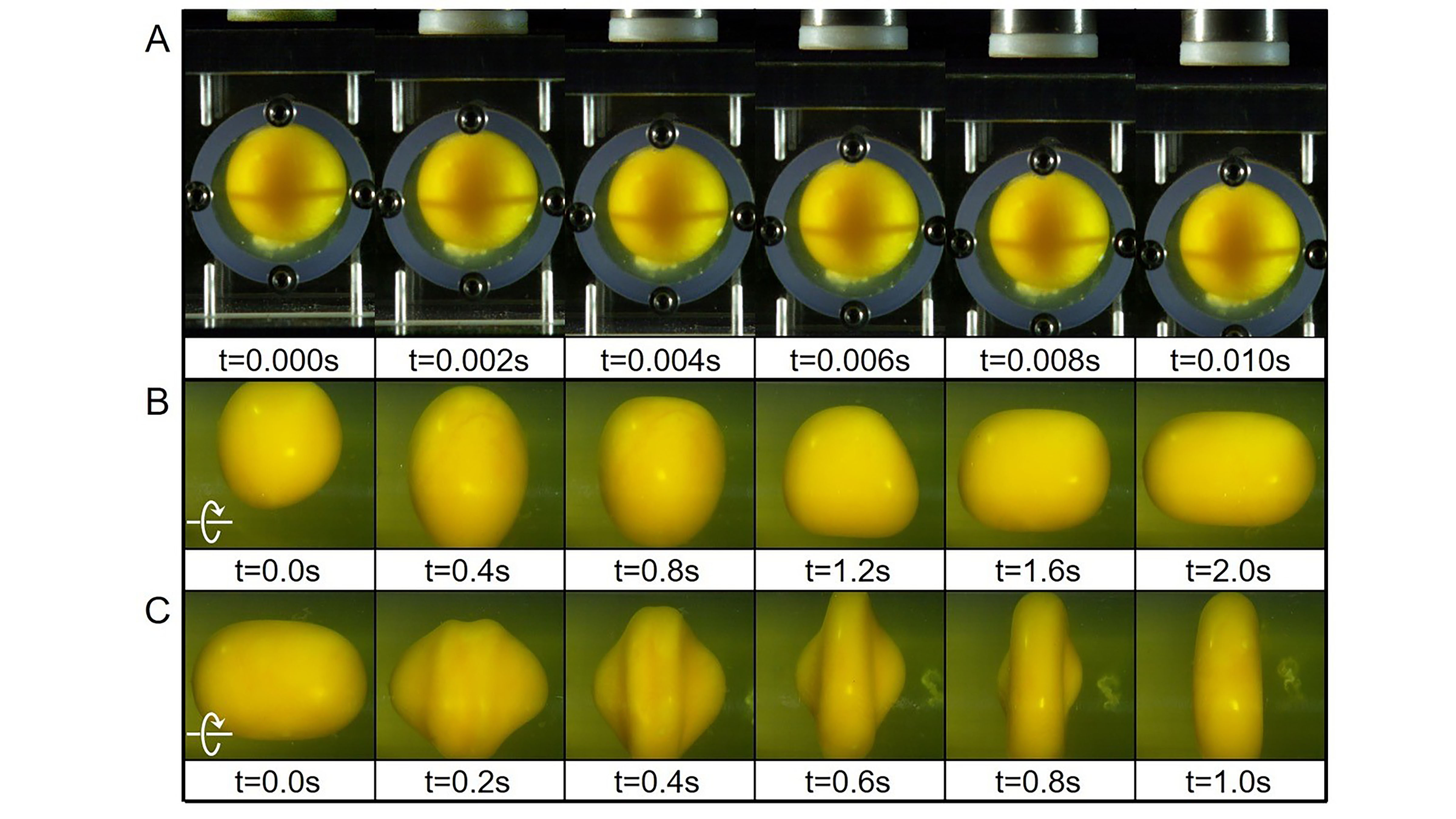
Eggs Reveal What May Happen to Brain on Impact
Our brains consist of soft matter bathed in watery cerebrospinal fluid inside a hard skull, and in Physics of Fluids, researchers describe studying another system with the same features, an egg, to search for answers about concussions. Considering that in most concussive brain injuries, the skull does not break, they wanted to find out if it was possible to break or deform the egg yolk without breaking the eggshell and did a simple experiment using an egg scrambler, measuring the soft matter deformation.
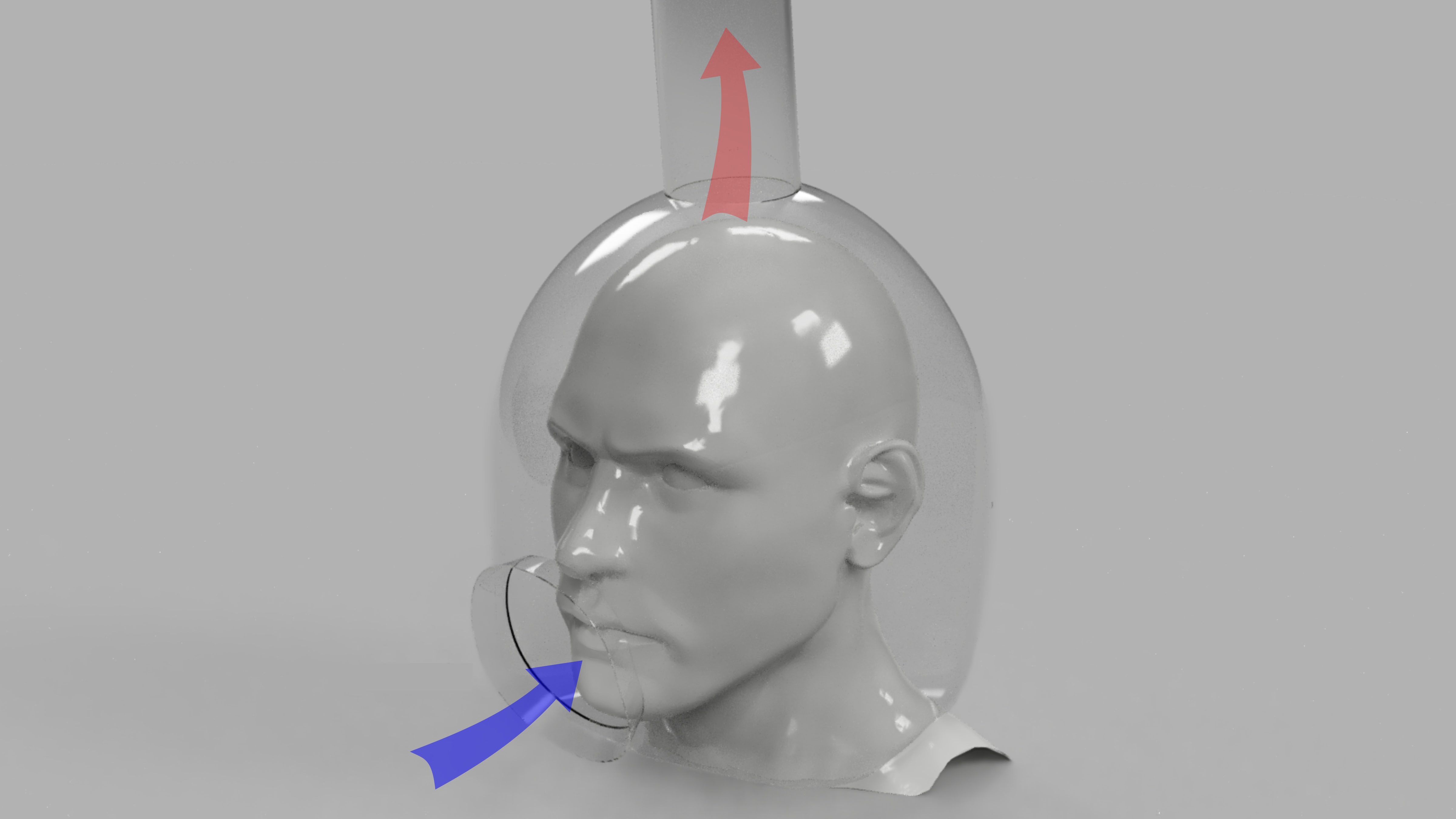
Disposable Helmet Retains Cough Droplets, Minimizes Transmission to Dentists, Otolaryngologists
Dentists and otolaryngologists are at particular risk of infection of COVID-19, since they need direct access to the mouth, nose, and throat of patients. The current solutions are expensive, not highly effective, and not very accessible. In Physics of Fluids, researchers discuss their design of an open-faced helmet for patient use that is connected to a medical-grade air filtration pump from the top that creates a reverse flow of air to prevent cough droplets from exiting the helmet.
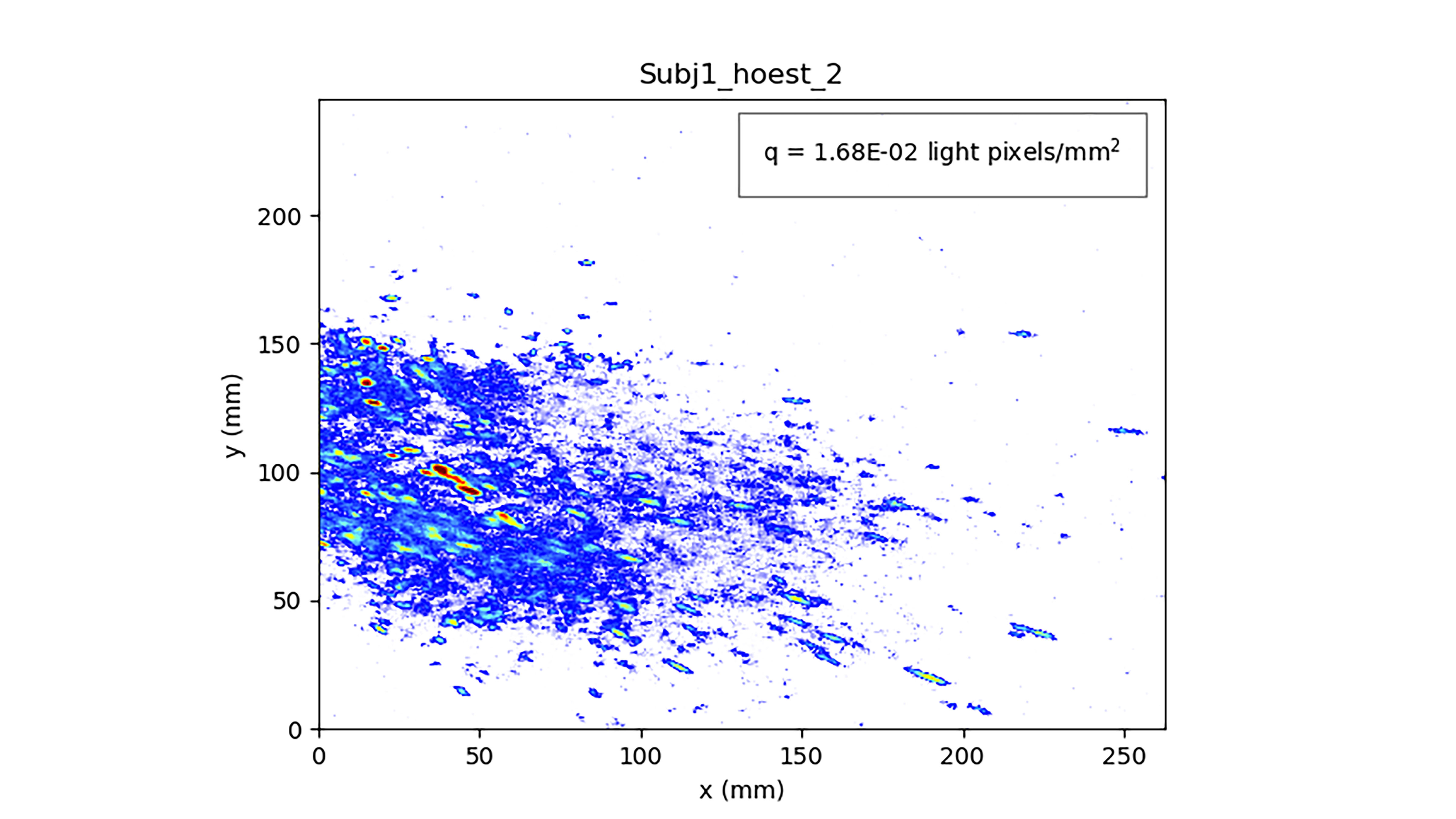
Hand-Held Device Measures Aerosols for Coronavirus Risk Assessment
Understanding aerosol concentrations and persistence in public spaces can help determine infection risks. However, measuring these concentrations is difficult, requiring specialized personnel and equipment. Now, researchers demonstrate that a commercial hand-held particle counter can be used for this purpose and help determine the impacts of risk-reducing measures, like ventilation improvements. They describe the quick and easy, portable process in the journal Physics of Fluids.

The Mask Matters: How Masks Affect Airflow, Protection Effectiveness
Even though it has been widely known that wearing a face mask will help mitigate the community spread of COVID-19, less is known regarding the specific effectiveness of masks in reducing the viral load in the respiratory tracts of those wearing them. In Physics of Fluids, researchers examined the effect of wearing a three-layer surgical mask on inspiratory airflows and the mask’s effects on the inhalation and deposition of ambient particles in the upper respiratory airways.
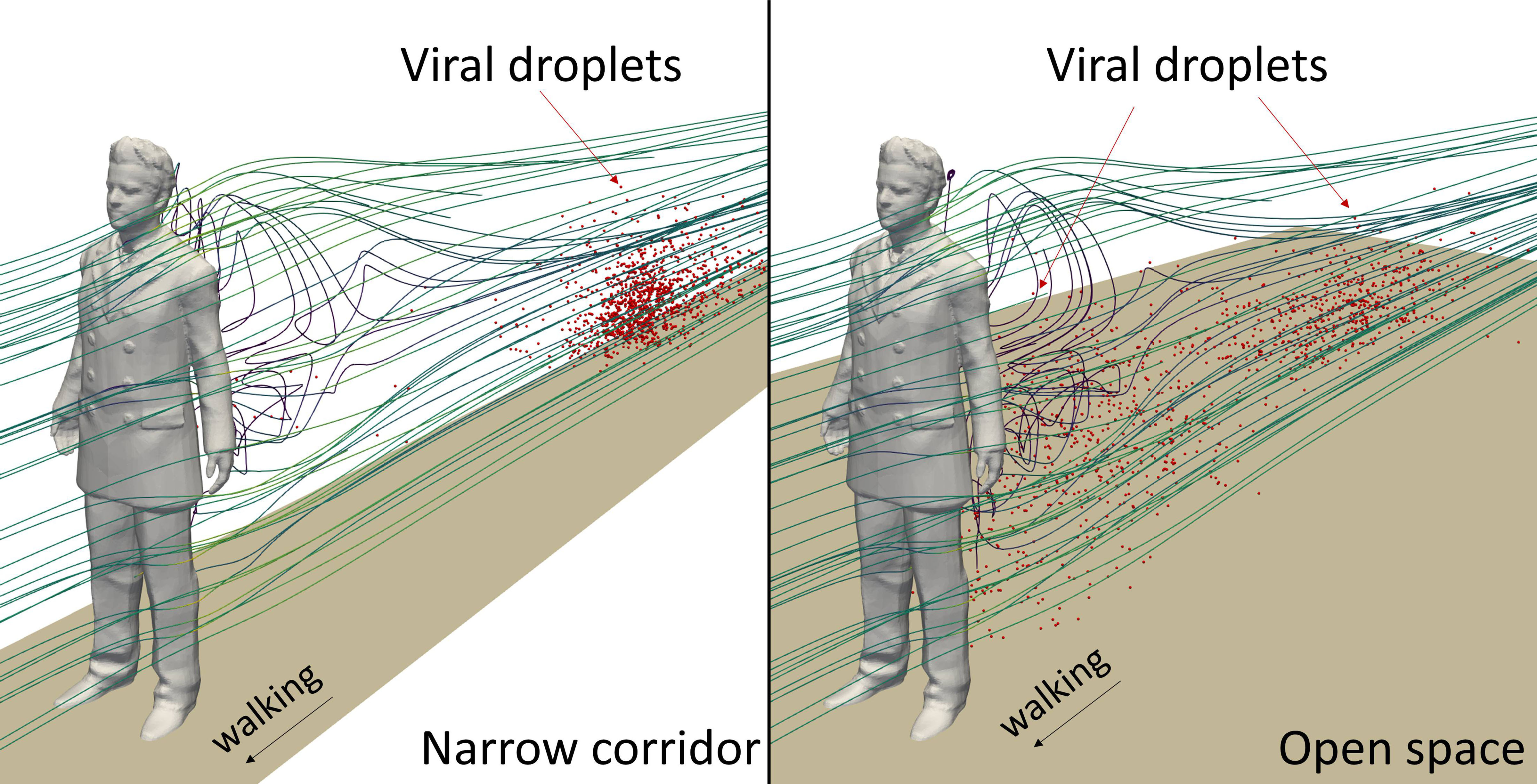
Fast Walking in Narrow Corridors Can Increase COVID-19 Transmission Risk
Simulations have been used to predict droplet dispersal patterns in situations where COVID-19 might be spread and results in Physics of Fluids show the importance of the space shape in modeling how droplets move. The simulations are used to determine flow patterns behind a walking individual in spaces of different shape. The results reveal a higher transmission risk for children in some instances, such as behind quickly moving people in a long narrow hallway.
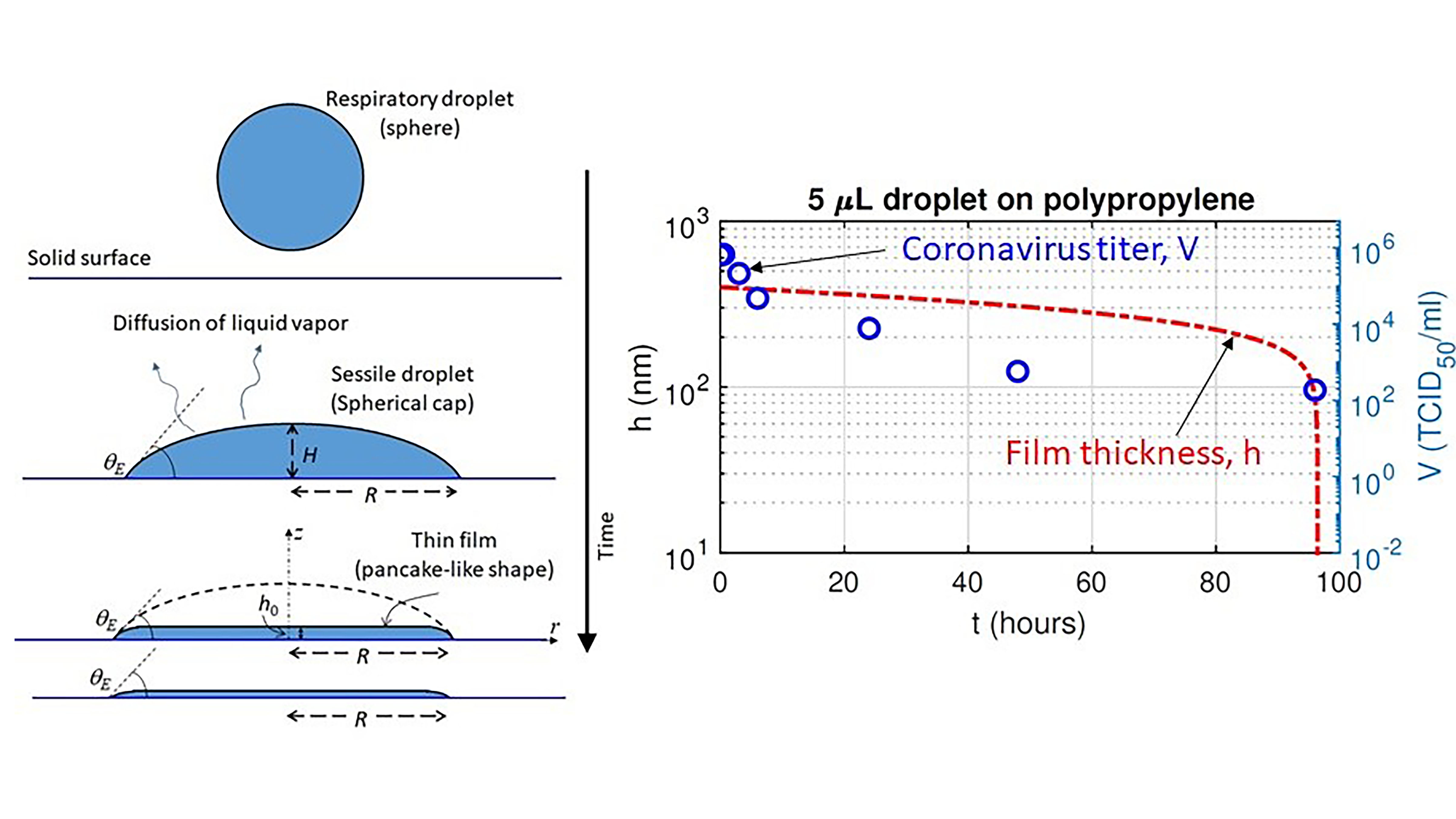
COVID-19 Virus Survives on Surfaces Within Thin Film
To find out how the COVID-19 virus survives on surfaces, researchers in India are exploring the drying times of thin liquid films that persist on surfaces after most respiratory droplets evaporate. While the drying time of typical respiratory droplets is on the order of seconds, the survival time of the COVID-19 virus was found to be on the order of hours. In Physics of Fluids, the researchers describe how a nanometers-thick liquid film clings to the surface, allowing the virus to survive.
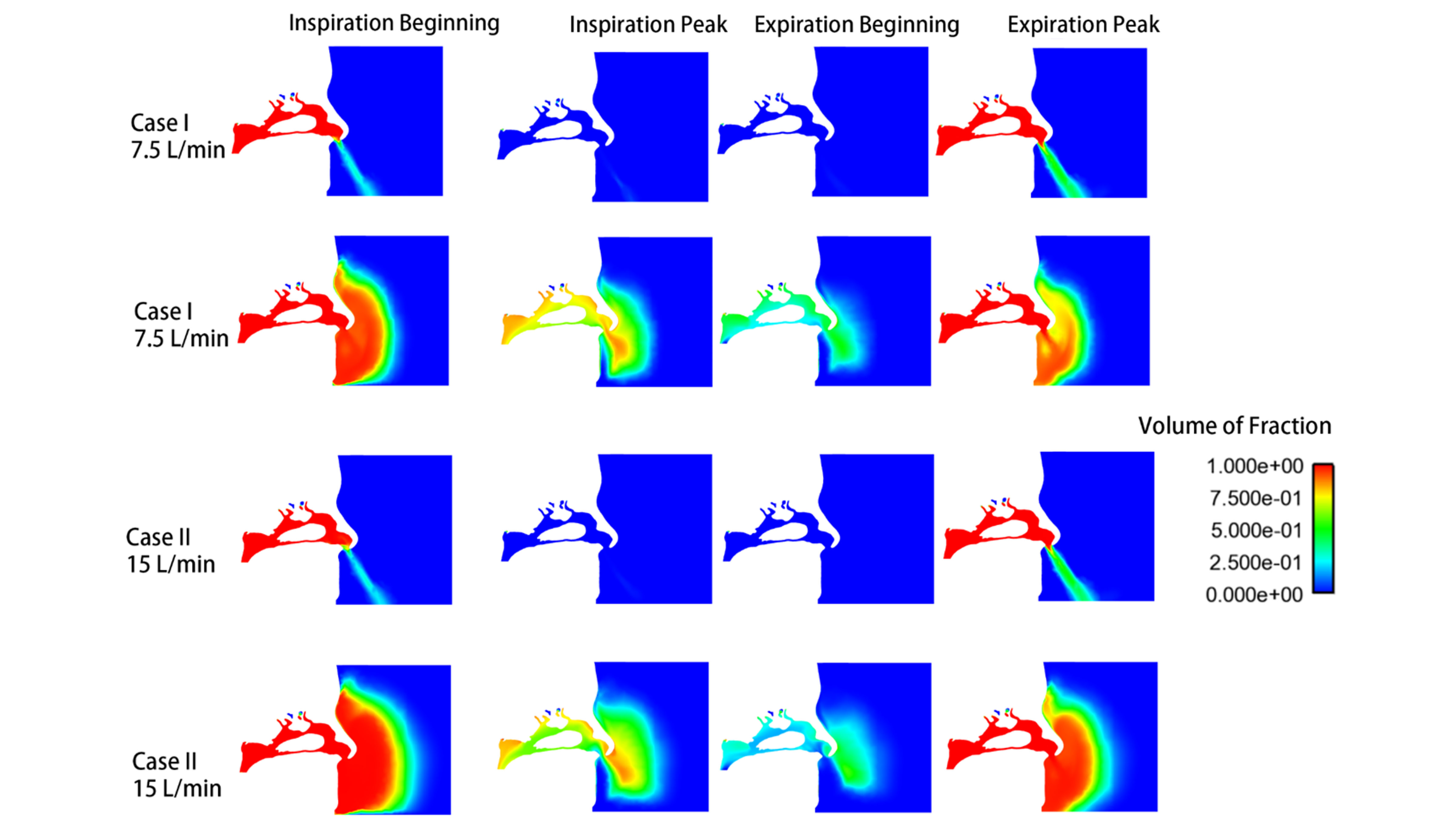
Face Masks Slow Spread of COVID-19; Types of Masks, Length of Use Matter
Using face masks to help slow the spread of COVID-19 has been widely recommended by health professionals. This has triggered studies of the materials, design, and other issues affecting the way face masks work. In Physics of Fluids, investigators looked at research on face masks and their use and summarized what we know about the way they filter or block the virus. They also summarize design issues that still need to be addressed.

Plasma Treatments Quickly Kill Coronavirus on Surfaces
Researchers from UCLA believe using plasma could promise a significant breakthrough in the fight against the spread of COVID-19. In Physics of Fluids, modeling conducted showed strains of the coronavirus on surfaces like metal, leather, and plastic were killed in as little as 30 seconds of treatment with argon-fed, cold atmospheric plasma. The researchers used an atmospheric pressure plasma jet they built with a 3D printer to spray surfaces that were treated with SARS-CoV-2 cultures.